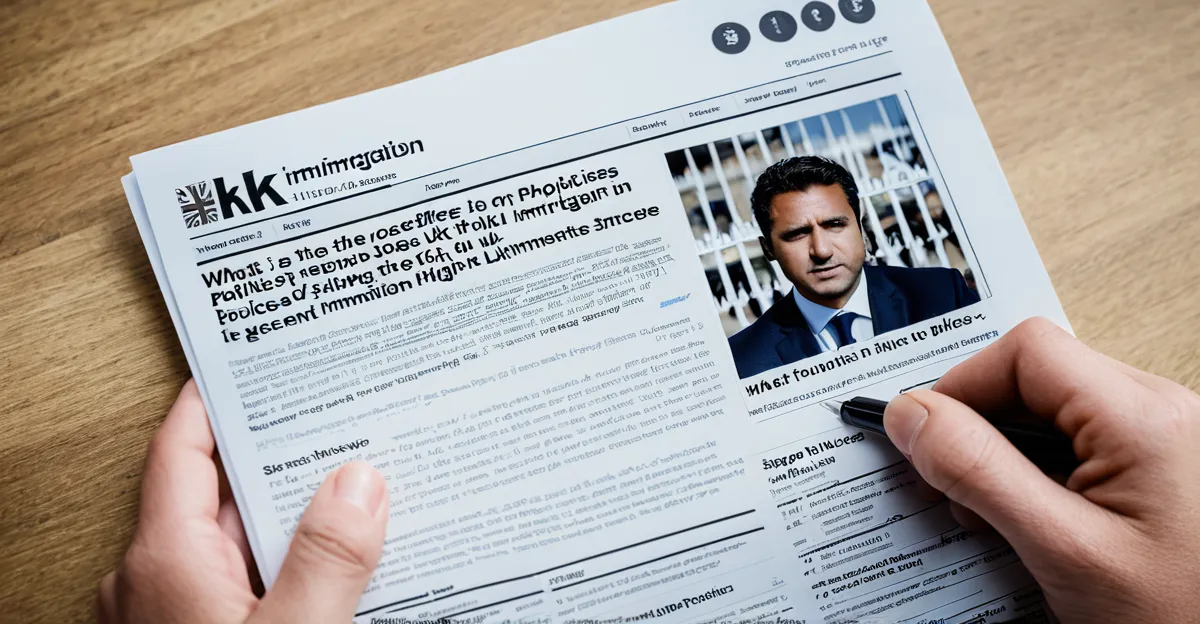Recent UK Migration Policies and Legislative Changes
Over the past five years, UK migration policies have undergone several substantial reforms, reshaping the landscape of UK immigration law. Key updates have targeted work, study, and asylum routes, reflecting shifts in the government’s approach to managing migrant inflows.
The introduction of the points-based immigration system in 2021 marks one of the most significant legislative changes, aiming to control skilled work migration more effectively. This system assigns points based on criteria such as job offer, skill level, and English language proficiency, ensuring that migrants contribute to economic priorities. Notably, the system replaced much of the freedom of movement previously enjoyed under EU membership, streamlining work visas but tightening restrictions for certain sectors.
Also read : How Does Brexit Impact the Education System in the UK?
On the study front, new visa requirements prioritize applicants from reputable educational institutions and impose stricter financial and English language conditions. These adjustments reflect broader policy goals to enhance the quality of international student inflows and their contribution to UK society.
Asylum pathways have also experienced legislative shifts, with increased emphasis on border enforcement and accelerated processes to deter irregular arrivals. The Nationality and Borders Act 2022 introduced tougher penalties for illegal entry and expanded detention powers, illustrating how political and social pressures are influencing migration policies.
Also to discover : How Has Brexit Affected the UK’s Relationship with the EU?
Political motivations are central to these reforms, with policymakers balancing public concerns over immigration levels and the need for skilled labor. Social discourse around integration and national security continues to guide policy updates, underscoring the complex environment in which UK migration policies evolve.
Understanding these legislative changes provides critical context for assessing their impacts on migration flows and the experiences of migrants navigating the UK’s immigration system.
Data and Official Reports on UK Migration Trends
Recent UK migration statistics reveal nuanced patterns following the substantial changes in UK immigration law. According to the latest Home Office reports, migration inflows and outflows have shifted across key categories: work, study, asylum, and family reunification.
Data analysis highlights that work-related migration has stabilized but remains selective due to the points-based system’s criteria. Skilled workers now constitute a larger proportion of inflows compared to previous years. For instance, the emphasis on job offers and skills has notably reduced lower-skilled worker entries, aligning with policy goals.
Study migration figures indicate a tightening of entry thresholds, which has led to a modest decline in student visa grants. The data suggest that applicants from high-ranking educational institutions form a majority, confirming the policy updates aimed at raising the quality of student intakes. However, some subject areas and regions dependent on international students report ongoing fluctuations in enrollment numbers.
Asylum seeker data reflect the impact of enhanced border enforcement and the Nationality and Borders Act 2022. The official reports show a decrease in asylum applications through irregular channels, while the overall asylum seeker population remains influenced by global geopolitical factors beyond domestic policy. Detention rates have increased, consistent with legislative shifts toward stricter control measures.
Regionally, major urban centers such as London, Manchester, and Birmingham continue to attract the bulk of new migrants, but there are emerging demographic shifts with more migrants settling in smaller cities and rural areas, prompted by economic opportunities and housing affordability. Family reunification migration has shown relative stability, reflecting the lesser emphasis on this pathway in recent policy discussions.
Overall, continuous migration data analysis underscores the complex effects of policy updates. The official statistics and independent data provide invaluable insights into how the evolving UK migration policies translate into real-world movements and demographic changes.
Analysis of Policy Impact on Migration Patterns
Understanding the impact of policy on migration requires examining how recent policy updates align with shifts in migration flows and characteristics. Data-driven migration trend analysis identifies clear cause-and-effect relationships between changes in the UK immigration law and observed migration behaviours.
The introduction of the points-based system has notably reduced low-skilled work migration, as supported by consistent declines in such entries reported in official statistics. This direct correlation demonstrates effective policy enforcement to prioritize skilled labour amid broader economic goals. Similarly, tighter student visa criteria have contributed to a modest contraction in study-related inflows, reflecting prioritization of applicants from reputable institutions and higher English language requirements.
Expert commentary highlights that while domestic UK migration policies heavily influence migration flows, external factors remain significant. For example, global geopolitical events continue to shape asylum seeker numbers independently of stricter border measures, complicating the attribution of trends solely to policy changes. However, increased detention rates and accelerated asylum procedures indicate policy-driven enforcement effects.
Moreover, migration trend analysis identifies demographic shifts away from traditional metropolitan concentrations towards smaller urban and rural areas. Analysts suggest this pattern stems partially from policy-induced changes in economic opportunities and housing affordability, illustrating the multifaceted consequences of legislative adjustments.
In summary, rigorous scrutiny of migration data and expert insights confirms that recent UK migration policies substantially impact migration patterns. Yet, the interplay with external variables calls for nuanced interpretation when attributing trends to specific legislative changes.
Broader Implications and Future Outlook
The future of UK migration is closely tied to the continuing evolution of UK migration policies and the broader socio-economic context. Current policy projections suggest that ongoing refinements in the UK immigration law will further prioritize skilled migration, thereby shaping labour market dynamics and addressing sector-specific shortages. For example, tightening visa requirements for lower-skilled roles is expected to persist, influencing the composition of work-related migration inflows.
Short-term migration policy consequences already include shifts in regional demographics, with increased settlement in smaller cities and rural areas emerging due to policy-driven economic redistribution and housing affordability. These trends may deepen as future policies encourage relocation to support local economies and ease pressure on major urban centres.
In the long term, the sustainability of the UK’s migration system depends on balancing security concerns and economic needs. Policymakers are likely to refine asylum processing and family reunification rules to align with international obligations while managing domestic public sentiment. Anticipated adjustments will also focus on enhancing integration mechanisms, fostering social cohesion amid evolving migration flows.
Projections indicate that migration patterns will continue to reflect both global influences and domestic legislation. External factors such as geopolitical events will still impact asylum claims, while innovations in immigration law may improve efficiency and adaptability. Overall, the future of UK migration will require adaptable, evidence-based policy updates that respond to economic realities and social expectations, ensuring that the UK remains competitive and inclusive.


